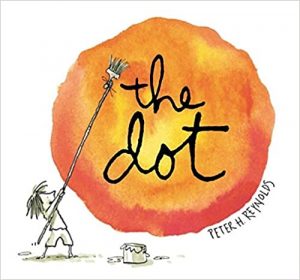Mental Health
The Dot

Author(s): Peter H. Reynolds
Links:
Amazon: https://amzn.to/2HAR5Cq
Indigo: https://bit.ly/2YvI6ZB
Social Justice focus: Creativity
Synopsis: The child in this story dislikes art class because she is convinced, she can’t draw. Her teacher gently encourages her to begin with a single dot and her creativity takes off. The story celebrates the creative spirit in everyone.
Lesson Plan: Taylor Simons
Junior/Intermediate Lesson Plan
Consecutive and Concurrent Programs
Unit/Topic: Language Arts – Writing: “I never thought I could”
Grade: 8
Lesson: The purpose of this lesson is to have students interpret their own meaning of The Dot, make connections between the book and personal, educational or life experiences, and communicate their understanding through a written reflection.
Curriculum Areas: Possible areas
Language Arts – Strand C: Comprehension: Understanding and Responding to Texts; Strand D: Composition: Expressing Ideas and Creating Texts
Visual Arts – OE D 1 & 2 Creating and Presenting; Reflecting, Responding, and Analyzing
Physical Education and Health – Mental Health (Grade 8 C2.3) Consider the effectiveness of support and feedback, explore ways to deal with stress
Curriculum Expectations: Language Arts – Comprehension
OE C1 Knowledge about Texts
SE C1.1 Using foundational knowledge and skills to comprehend text
OE C3 Critical Thinking in Literacy
SE C3.3 Analyzing texts
SE 3.6 Analysis and response
Language Arts – Composition
OE D2 Creating Texts
SE D2.1 Producing drafts
SE D2.5 Revision
SE D2.4 Point of view and perspective
Learning Goal(s):
- Identify themes and generate meanings of the Dot (K) (T)
- Make connections between the book and personal, educational, and/or life experiences (T) (A)
- Convey meaning through a first person POV written reflection (C) (A)
Success Criteria:
- I can discuss ideas with my peers and ask questions
- I can identify an overall message of the book
- I can generate my own meaning from the book
- I can explain how I relate or do not relate to Vashti and her experience
- I can write a 1-page written reflection in my POV using personal experiences or other experiences that are similar to Vashti’s
MODIFICATIONS / ACCOMMODATIONS
- Learning Styles:
- Visual: Class can build concept map on board together, lists to show ideas
- Auditory: Create opportunities for verbal discussion, one LOUD and CLEAR voice
- Kinesthetic: Imitate the book (Create something you never thought you could)
- Exceptionalities/Disabilities/Special Needs & Other Considerations
- Projector to see the book (words, pictures),
- One reader with loud and clear voice
- Work with a partner to discuss ideas
- Use technology or digital support
Minds-on: Icebreaker drawing activity, classroom discussion, introduction to book.
Minutes: 10 minutes
Task:
Students will draw a picture on a blank piece of paper; it can be anything they wish, using whatever writing utensils they have.
Teacher will observe.
Classroom discussion afterwards, discussing difficulties, choices, pictures, likes and dislikes about the task. Students will be asked to sign their artwork.
Introduction and read through of The Dot
Assessment: Observation – For learning – teacher will observe and listen to student discussion to clarify students learning and check for understanding.
Action: Class/Peer Discussion and Written Reflection
Minutes: 40 minutes
Task:
CLASS & PARTNERS: After the book has been read aloud to the class, teacher can use these discussion prompts with the entire class:
- How did you feel when you signed your artwork?
- Are you proud of your drawing?
- Has there ever been a time where you thought you couldn’t do something and then you did it?
Students will then work with their elbow partner to brainstorm ideas about the book’s meaning and begin to build connections between their own experiences (past or present) and Vashti’s experience in the book.
INDIVIDUAL: Students will write a 1-page reflection, first person POV, that discusses any themes, meanings, and connections they made to the book.
Assessment: As and for learning – students will reflect on their own understanding and try to make deeper connections to the book. Teacher will observe and check reflections for understanding, critical thinking, and communication; this will give the teacher an idea of where the students are and what they will need in order to build on their literacy skills in future lessons.
Consolidation: Exit card
Minutes: 5 minutes
Task: Students will complete an exit card that will ask them to share the most important concept/lesson they learned from The Dot.
Assessment: As learning – The exit card is inviting them to make one conclusive and meaningful statement to demonstrate what they have learned. It encourages deeper thinking, summary of ideas, and will help students to adjust their mindsets in future academic settings.
MATERIALS:
- The Dot Picture book
- Blank paper
- Pencils/Markers/Pencil Crayons
- Notebooks/ iPads/Laptops
- *Possible* Examples of success stories for students to see connections
REFLECTION:
Questions to determine the success of your lesson-
- Were my students successful in meeting the learning goals and success criteria? How do I know?
- Did my instructional decisions meet the needs of all students? If not, what are my next steps?
- What worked well and why?
- What will I do differently in the future when teaching this lesson? For the subsequent lesson?
- What are the next steps for my professional learning?

